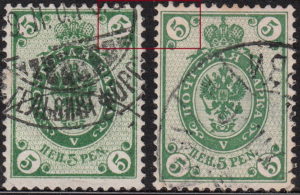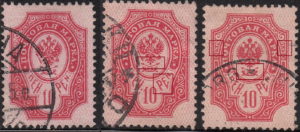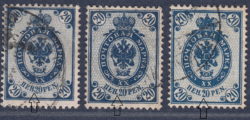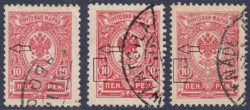Varieties and types of postage stamps of the Grand Duchy of Finland
1901. Russian coat of arms, denomination in Finnish currency.
Values from 2 penniä to 1 markka printed in letterpress, perforation 14¼:14¾. Value of 10 markka printed in combined letterpress and embossed print, perforation 13½.
Types
| TYPES |
| 5 penniä, dark olive green |
| I, II |
 |
Type I, 14. January 1901:
- white spacing between inner and outer frame narrow.
Type II, 18. February 1901:
- white spacing between inner and outer frame wide.
|
| 10 penniä, carmine |
| I, II, III |
 |
Type I, 14. January 1901:
- corner ornaments regular,
- arrowheads below coat of arms short,
- base of letter P in PEN. rounded,
- bottom stroke of letter E in in PEN. straight.
Type II, 10. September 1901:
- corner ornaments regular,
- arrowheads below coat of arms long,
- base of letter P in PEN. straight,
- bottom stroke of letter E in in PEN. slightly curved.
Type III, 8 July 1908:
- corner ornaments re-engraved,
- arrowheads below coat of arms short,
- base of letter P in PEN. rounded,
- bottom stroke of letter E in in PEN. straight.
|
| 20 penniä, dark blue |
| I, II, III |
 |
Type I, 14 January 1901:
- dot between H and 2 in denomination exactly in the middle,
- pattern of the background net poorly visible.
Type II, 5 September 1901:
- dot between H and 2 in denomination closer to the letter H,
- pattern of the background net well visible,
- points of the arrows crossing the post horn are long and pointed.
Type III, 11 August 1909:
- serifs in numeral 2 in denomination short,
- background well visible,
- points of the arrows small.
|
1911. Russian coat of arms, denomination in Finnish currency.
Printed in letterpress. Perforations comb 14¼ to 14¼:14 and comb 14¼:14¾.
| TYPES |
| 10 penniä, carmine |
| I, II, III |
 |
Type I, 14 January 1911:
- borderline thin,
- horizontal lines above and below denomination narrow.
Type II, 14 October 1913:
- borderline thick,
- horizontal lines above and below denomination wide.
Type III, 25 July 1915:
- borderline thick,
- horizontal lines above and below denomination narrow.
|
Bibliography
- Michel Nord- und Nordwesteuropa 2005/2006, Schwaneberger Verlag GmbH, ISBN 3-87858-683-3





